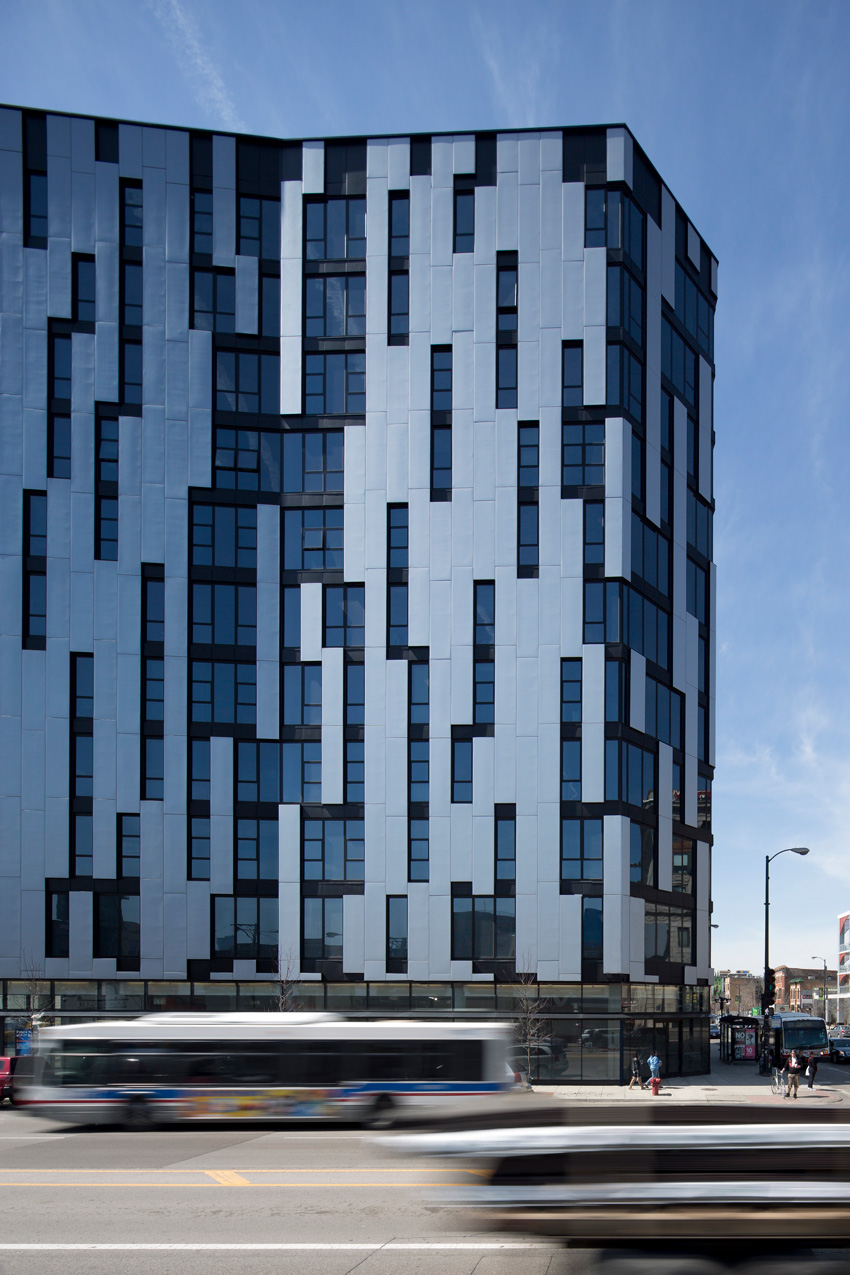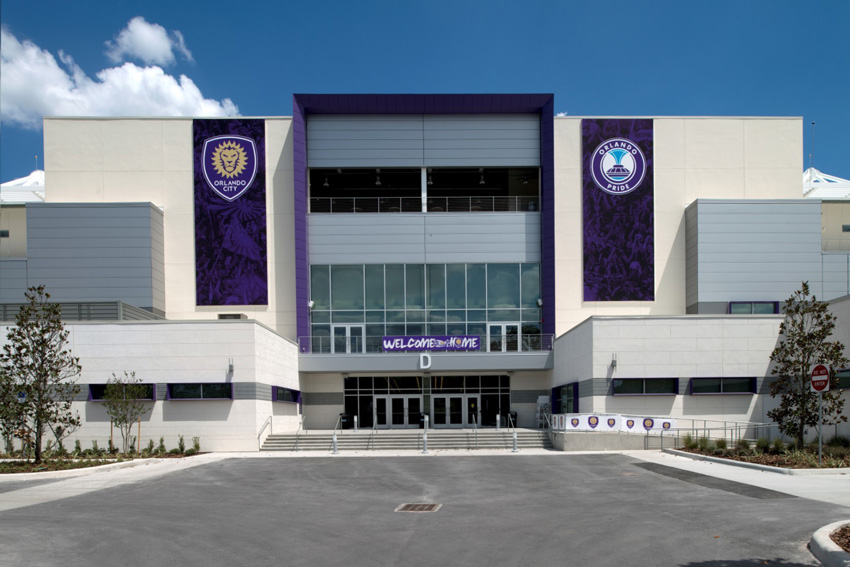This CE Center article is no longer eligible for receiving credits.
This course is part of the Metal Architecture Academy
Known for its exceptional aesthetics, envelope performance, spanning abilities, and one-step installation, insulated metal panels (IMPs) are a popular choice for today’s commercial, institutional, and industrial facilities.
Breaking out beyond its traditional cold-storage applications, architects and building owners are taking advantage of IMPs's growing architectural options, aesthetics, structural integrity, energy efficiency, lightweight, and low maintenance for a wide variety of projects ranging from corporate settings to sports facilities to educational buildings.
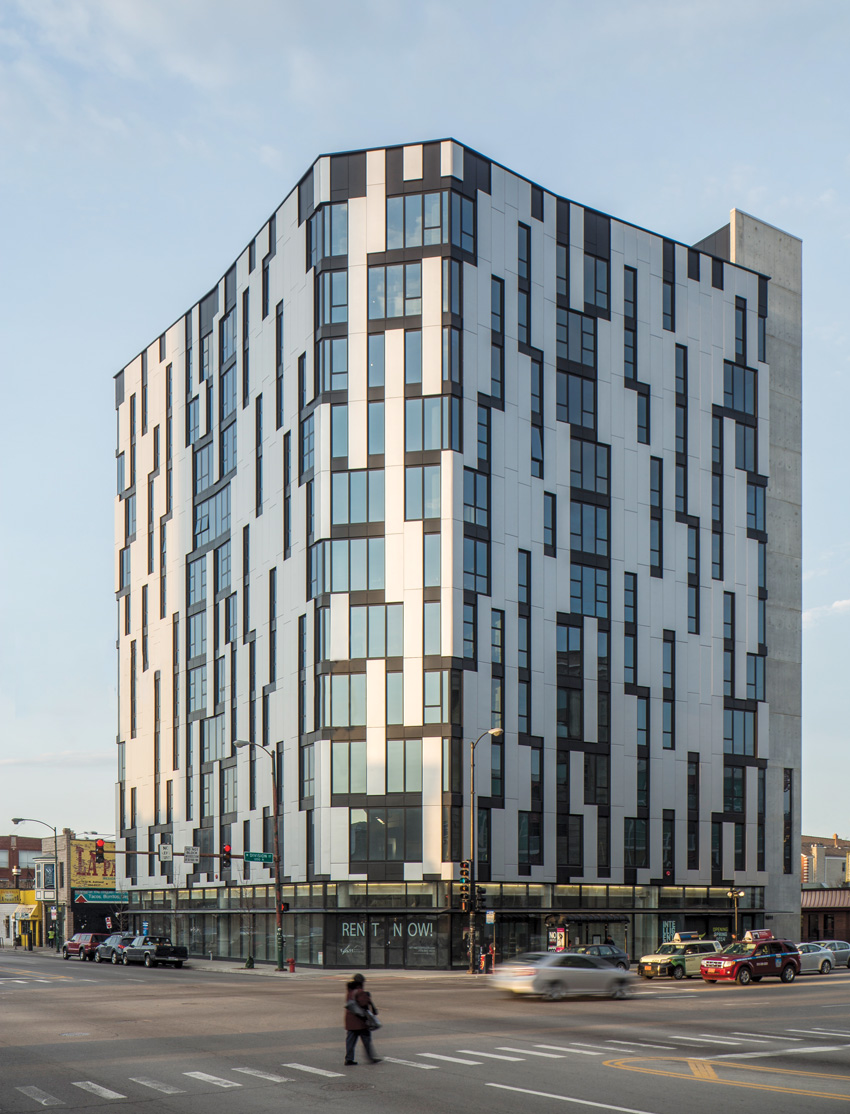
Photo courtesy of Kingspan
Insulated metal panels are an attractive, energy-efficient, and cost-effective way to deliver a turnkey building enclosure with a vapor and water barrier and continuous insulation, as pictured here at Chicago’s 1611 West Division apartment complex.
"Using IMPs is a frequent practice with many of our projects," reports Cassie Robertson, preconstruction manager, DPR Construction, Phoenix. "If you have a client that's looking for a good-looking facade but not wanting to exert the time, money, and effort on a customized project, IMPs are a great solution to get an insulated facade up rather quickly.”
"They are a holistic design solution, which drastically reduces install time in lieu of other materials that require multiple trades and multiple schedules," adds Bruce Beahm, AIA, principal, Populous, Kansas City, Missouri.

Photo courtesy of RHEINZINK
Clad in zinc panels, IMPs enclose the new 110,000-square-foot Williamson College of Business at Youngstown State University in Youngstown, Ohio.
As a turnkey option, delivering a full vapor and water barrier—along with continuous insulation— IMPs are an easy way to meet growing code requirements, which Robertson says is a major selling point amongst end users.
To deliver this high-performance insulation, foam is injected between two metal sheets where it then undergoes a chemical reaction, causing it to rise and bond to the metal skins, thereby filling the interior cavity. The result is a solid monolithic panel that maintains a consistent thermal value and also resists moisture, insect, and rodent infiltration.
As of recently, IMPs are not only considered the primary exterior finish but are also now being designed in as the primary building envelope that can be clad with various secondary rainscreen materials, relates Dan Hooper, president, Universal Wall Systems, Grand Rapids, Michigan.
“This barrier wall provides a quick building enclosure over a simple framing system that can facilitate the schedule of the interior buildout, and ultimately reduce the overall project schedule and cost of the project general conditions,” he says.
Array of Design Options
Coming a long way from the uniform, boxed designs of the 1960s, today’s IMP manufacturers offer a growing palette of design options, including a wide range of flat and profile panels, color, texture, panel width, joint size options, and joint orientations. IMPs can also be curved and formed, and come in a variety of high-performance coatings.
“IMPs have developed from the early ribbed metal-faced panels to now include a variety of smooth and textured metal modular wall panels integrated with reveals, trim, windows, and louvers,” reports Phil Kazba, FCSI, CCS, AIA, SpecGuy Specifications Consultants, Mount Dora, Florida.
Expanding upon the various profiled options, designers can choose walls that are ribbed, fluted, or planked. For flat walls, they can be flat, textured, or striated.
Additional design features include joint reveal widths, formed corner panels, end folds and treatments, heavier gauge flat facings, and high-performance coatings. Performance wise, architects can specify various panel insulation values, span lengths, and load/span capabilities.
“From an architectural perspective, the panel sizes, orientation jointing, exposure, cuts, texture, etc. are all commonplace items to consider with metal panel fabrication,” explains Robertson.
For IMP roof systems, the latest products come in a nice array of colors, textures, finishes, and sizes. Typical modules are sized at 24 inches, 30 inches, 36 inches, and 42 inches, with thicknesses ranging from 2 inches to 6 inches, and lengths from 8 feet up to 52 feet.
For improved appearance with economy, architects can specify multiple profiles to the metal facing, such as light striations, planking, deep ribbing, or stiffening beads.
Another feature is embossing, which creates surface texture on metal coils. This process flattens wavy coils and eliminates the "mirror” effect of smooth finishes. It is also a useful way to mask minor blemishes such as paint scratches and surface variations. Nondirectional embossing can be applied to create a uniform pattern, whereas directional embossing produces linear lines along the length of the coil.
The most commonly used metal substrate for IMP faces are G90 galvanized steel or aluminum-zinc coated steel, while some custom panels are made from stainless steel or aluminum.
A typical interior finish is a standard polyester 0.8 millimeter—including the primer—in a light-reflective and easy-to-maintain color. United States Department of Agriculture (USDA)-compliant finishes and stainless steel are also available for required applications, such as food processing and storage.
To help architects navigate through the various options, Kevin Haugh, AIA, architect, associate, CRB, Broomfield, Colorado, recommends working with product reps to gain exposure and gather input on the different uses and types of panels offered. “Manufacturers have the experience and product knowledge to steer architects to the right product for the application,” he says. “Usually the architectural conceptual design will drive the panel profile. Then, using vendor information, we find a panel that meets the design intent.”
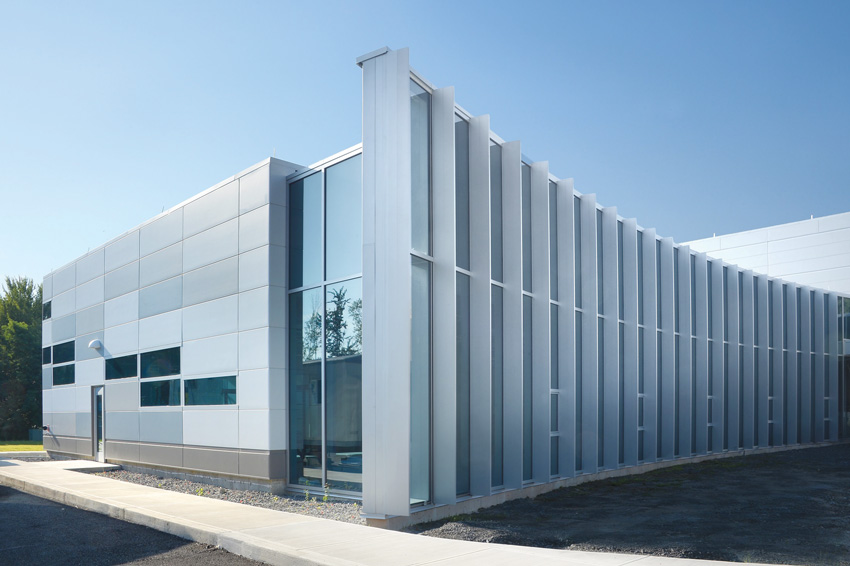
Photo courtesy of Metl-Span
The new headquarters for Soraa, a leading developer of solid-state lighting products, features a smooth, flat exterior incorporating more than 22,000 square feet of 3-inch, 22/26-gauge architectural wall panels in a blend of white and granite hues.
“Invite these manufacturers to your office for a discussion around current projects these solutions could apply to and allow them to demonstrate their product lines and show photos of built projects,” agrees Beahm. “They can be a valuable guide when selecting the right IMP system for specific projects to ensure the product meets the design intent and is detailed to include proper fit and finish.”
Incidentally, Beahm also recommends visiting built projects to see the products installed first hand. This includes speaking with venue owners who utilize IMPs and asking them about their satisfaction levels.
This course is part of the Metal Architecture Academy
Known for its exceptional aesthetics, envelope performance, spanning abilities, and one-step installation, insulated metal panels (IMPs) are a popular choice for today’s commercial, institutional, and industrial facilities.
Breaking out beyond its traditional cold-storage applications, architects and building owners are taking advantage of IMPs's growing architectural options, aesthetics, structural integrity, energy efficiency, lightweight, and low maintenance for a wide variety of projects ranging from corporate settings to sports facilities to educational buildings.

Photo courtesy of Kingspan
Insulated metal panels are an attractive, energy-efficient, and cost-effective way to deliver a turnkey building enclosure with a vapor and water barrier and continuous insulation, as pictured here at Chicago’s 1611 West Division apartment complex.
"Using IMPs is a frequent practice with many of our projects," reports Cassie Robertson, preconstruction manager, DPR Construction, Phoenix. "If you have a client that's looking for a good-looking facade but not wanting to exert the time, money, and effort on a customized project, IMPs are a great solution to get an insulated facade up rather quickly.”
"They are a holistic design solution, which drastically reduces install time in lieu of other materials that require multiple trades and multiple schedules," adds Bruce Beahm, AIA, principal, Populous, Kansas City, Missouri.

Photo courtesy of RHEINZINK
Clad in zinc panels, IMPs enclose the new 110,000-square-foot Williamson College of Business at Youngstown State University in Youngstown, Ohio.
As a turnkey option, delivering a full vapor and water barrier—along with continuous insulation— IMPs are an easy way to meet growing code requirements, which Robertson says is a major selling point amongst end users.
To deliver this high-performance insulation, foam is injected between two metal sheets where it then undergoes a chemical reaction, causing it to rise and bond to the metal skins, thereby filling the interior cavity. The result is a solid monolithic panel that maintains a consistent thermal value and also resists moisture, insect, and rodent infiltration.
As of recently, IMPs are not only considered the primary exterior finish but are also now being designed in as the primary building envelope that can be clad with various secondary rainscreen materials, relates Dan Hooper, president, Universal Wall Systems, Grand Rapids, Michigan.
“This barrier wall provides a quick building enclosure over a simple framing system that can facilitate the schedule of the interior buildout, and ultimately reduce the overall project schedule and cost of the project general conditions,” he says.
Array of Design Options
Coming a long way from the uniform, boxed designs of the 1960s, today’s IMP manufacturers offer a growing palette of design options, including a wide range of flat and profile panels, color, texture, panel width, joint size options, and joint orientations. IMPs can also be curved and formed, and come in a variety of high-performance coatings.
“IMPs have developed from the early ribbed metal-faced panels to now include a variety of smooth and textured metal modular wall panels integrated with reveals, trim, windows, and louvers,” reports Phil Kazba, FCSI, CCS, AIA, SpecGuy Specifications Consultants, Mount Dora, Florida.
Expanding upon the various profiled options, designers can choose walls that are ribbed, fluted, or planked. For flat walls, they can be flat, textured, or striated.
Additional design features include joint reveal widths, formed corner panels, end folds and treatments, heavier gauge flat facings, and high-performance coatings. Performance wise, architects can specify various panel insulation values, span lengths, and load/span capabilities.
“From an architectural perspective, the panel sizes, orientation jointing, exposure, cuts, texture, etc. are all commonplace items to consider with metal panel fabrication,” explains Robertson.
For IMP roof systems, the latest products come in a nice array of colors, textures, finishes, and sizes. Typical modules are sized at 24 inches, 30 inches, 36 inches, and 42 inches, with thicknesses ranging from 2 inches to 6 inches, and lengths from 8 feet up to 52 feet.
For improved appearance with economy, architects can specify multiple profiles to the metal facing, such as light striations, planking, deep ribbing, or stiffening beads.
Another feature is embossing, which creates surface texture on metal coils. This process flattens wavy coils and eliminates the "mirror” effect of smooth finishes. It is also a useful way to mask minor blemishes such as paint scratches and surface variations. Nondirectional embossing can be applied to create a uniform pattern, whereas directional embossing produces linear lines along the length of the coil.
The most commonly used metal substrate for IMP faces are G90 galvanized steel or aluminum-zinc coated steel, while some custom panels are made from stainless steel or aluminum.
A typical interior finish is a standard polyester 0.8 millimeter—including the primer—in a light-reflective and easy-to-maintain color. United States Department of Agriculture (USDA)-compliant finishes and stainless steel are also available for required applications, such as food processing and storage.
To help architects navigate through the various options, Kevin Haugh, AIA, architect, associate, CRB, Broomfield, Colorado, recommends working with product reps to gain exposure and gather input on the different uses and types of panels offered. “Manufacturers have the experience and product knowledge to steer architects to the right product for the application,” he says. “Usually the architectural conceptual design will drive the panel profile. Then, using vendor information, we find a panel that meets the design intent.”

Photo courtesy of Metl-Span
The new headquarters for Soraa, a leading developer of solid-state lighting products, features a smooth, flat exterior incorporating more than 22,000 square feet of 3-inch, 22/26-gauge architectural wall panels in a blend of white and granite hues.
“Invite these manufacturers to your office for a discussion around current projects these solutions could apply to and allow them to demonstrate their product lines and show photos of built projects,” agrees Beahm. “They can be a valuable guide when selecting the right IMP system for specific projects to ensure the product meets the design intent and is detailed to include proper fit and finish.”
Incidentally, Beahm also recommends visiting built projects to see the products installed first hand. This includes speaking with venue owners who utilize IMPs and asking them about their satisfaction levels.
Project Team Best Practices
In order to ensure a successful IMP design and installation, like any building project, building team communication and coordination is key, as is leveraging the manufacturers’ expertise.
Regarding the latter, Haugh describes the optimal scenario as having these experts on board early, where they can provide input on constructability and detailing specific to the product. "An integrated design project delivery method facilitates this well," he says.
Similarly, Ray Elking, preconstruction director, McCarthy Building Companies, St. Louis, points out, "Especially for complex projects, it is always beneficial for the designer, contractor, and manufacturer to collaborate closely to make sure everyone understands what the goals are and what can be achieved."
For example, by involving the manufacturer early in the process, all the flashing, sealant, and vapor barrier detailing can be part of the bid drawings.
As noted, there are numerous IMP options for metal panel finishes, configurations, sizes, and styles. "There are no shortcuts to becoming an expert quickly on these intricate topics," cautions Robertson. But if the architect chooses to engage the IMP manufacturer early on, then it can provide the guidance required to make the right decisions and get the best value for the project team's time, money, and resources.
She adds that taking a design-assist approach is ideal for exterior facades but will only work if there is a pool of qualified subcontractors to choose from. Qualified IMP installers are normally trained and certified by the manufacturer to execute proper procedures and details for a weathertight envelope.
On the other hand, if the building team does not spend the time seeking out qualified and experienced IMP installers, it may end up with a situation where the product’s features and economies of scale are not fully realized.
“Some installers are not confident in their ability to sufficiently deal with moisture infiltration at the IMPs’ openings and joints,” explains Jon Heinert, AIA, principal, Wheeler Kearns Architects, Chicago. “We have experienced issues with installers not willing to provide a warranty for the systems as engineered, unless a secondary weather barrier material is installed under the panel that is separately flashed to openings and penetrations.”
While manufacturers acknowledge that some special cases may justify a redundant and separate barrier system behind IMPs, most IMPs are designed to form a very effective air and water barrier through the use of factory-installed gaskets or non-curing sealants, along with properly detailed conditions at openings and other areas critical to water entry.
“Every IMP project that has ever been installed has openings and penetrations that have been properly flashed, sealed, and present no long-term warranty issues,” insures Kim Harrell, national sales manager, All Weather Insulated Panels, Vacaville, California.
Sharing a positive experience working closely with the architect and an IMP manufacturer for a large sports team franchise project, Sage Lehr, engineering manager of the St. Louis-based contractor IWR North America, specializing in the building enclosure, relates that it was ideal working with the project team in reviewing and modifying details prior to submitting drawings. With this approach, it was easy to resolve detail issues, keep the architect’s design intact, and meet the thermal values required for the zone 6 application.
“Running thermal models helped in making these changes, and having the engineering support of a large IMP manufacturer made it easier to get things executed on the frontend. The whole job was executed smoothly from paper to installation,” she reports.
Emphasizing this point once again, Hooper stresses the advantage of possessing a strong understanding of the manufacturer’s capabilities and limitations, as well as the correct application of the product. “In addition, communicating with the manufacturer and following the correct protocol ensures that the materials will be produced correctly and when needed to support the project schedule,” he says.
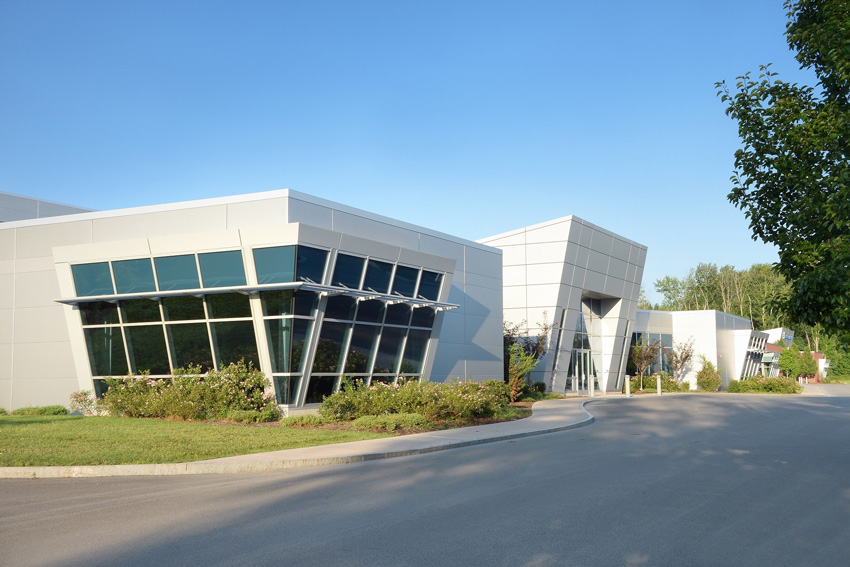
Photo courtesy of Metl-Span
Seeking a contemporary aesthetic, QPK Design specified a high-performance, modern IMP facade to complement Central New York Film Hub’s cutting-edge studio and soundstage.
Another key piece of advice offered by those who have designed and installed successful IMP projects is the importance of educating architects about the details of the IMP installation process.
“The more that architects understand about the correct application and limitations of IMPs, the more likely we are to ensure more successful IMP installations,” assures Hooper.
Similarly, Haugh explains that in order to get the details right, the architect needs to understand how the panels will be installed. For example, tolerances for panel installation are key where it connects to steel, joins concrete, or butts up to storefront systems or other building elements. “As with any material, understanding how it goes together can prevent an architect from including design elements that don’t work in the field,” he says.
Because each IMP has its own unique features—for example, the place where the panels attach to secondary supports will vary from manufacturer to manufacturer—it’s important that the architect has a good understanding of the spacing of the supports, the size of the panels, and their attachment points.
For the subcontractor, it’s important that the inevitable thermal bowing—when the exterior skin bows up slightly between purlins/joists—is taken into account as part of the bidding and installation process. This sometimes means that crews in the field have to rotate panels to expose the cooler side to the sun so that the panels can flatten out before installation.
Furthermore, IMP manufacturers offer varying choices in color, panel sizing, and thickness, for example, so architects should know their options.
Generally speaking, Robertson’s personal philosophy is that architects truly need to understand the properties of any materials they are specifying. And in the case of IMPs, knowing the product’s properties and limitations will significantly increase the chances of a successful project.
“Unfortunately, a common money saver is to use a thinner metal panel gauge, but depending on the size and orientation of the panels, this could cause oil canning,” she warns. Oil canning is visible waviness in the flat areas of metal roofing and metal wall panels. Similarly, architects might specify alternate metal panels, but depending on the panel size and orientation, this may compromise the design or quality of the installation.
“An architect who understands the properties of the materials will be better suited to guide the client and team to make the optimal decision about how an alternate will affect the project,” she says.
IMP Bidding
Once IMPs are selected for a building, it’s time for the contractors and subcontractors to bid on the project. To ensure that this process moves along smoothly, it is important that the scope is well defined. This begins with determining that the material specified is appropriate for the application. For example, is the span of steel being requested going to work for the application?
“Making sure that what is specified aligns with what the architect and owner are looking for ensures the project is set up for success from the start,” explains Elking.
At this point in the project, input from a qualified installer is key to ensure that the correct application of material from any of the specified manufacturers is being utilized.
Hooper adds that in many cases, specifications are written in such a way that they not only indicate the required product configuration but also the method of panel fabrication required from the manufacturer. “In these situations, installers that are not proactive in guiding the specification early in the process can face an uphill battle trying to utilize the product that is the best for both the application and the end user.”
This involves fully grasping the building structure design so that installers can best determine the tolerances for the metal panels. “This detailing can swing the number,” cautions Robertson.
Assisting contractors and installers with this process, software programs to manage drawings and take-off materials can be very useful.
“As we get revised drawings, the program we use allows us to do overlays so we can quickly see the changes. We can mark up details, save, and use the markups for any questions we may have,” explains Lehr.
The program also enables contractors to take off linear feet of flashing or extrusions as well as the square footage of the panels needed.
In terms of the general installation, contractors must be aware of the size and location of the laydown area, the weight and length of the panels, and what equipment can be used to set up the panels. Contractors should study the drawings and schedule in order to determine if other structures or landscaping might become problematic during installation, adds Lehr.
Unloading and Storing IMPs
When the construction phase of an IMP project commences, contractors will find the product protected with wood bundles or packaged in plastic shrink wrap.
When unloading, Lehr recommends using a minimum of four Nylon band slings, at least 4 inches wide, around the entire bundle/crate in a vertical position. To prevent the panels from shifting of sliding during the pick, the load must be safely balanced. For panels longer than 20 feet, IWR uses a spreader bar to maintain an even position of the slings. The use of cable or rope as a sling is not recommended, as this type of force concentration can damage the profiles metal edges of the panels.
If the panels are being unloaded to an elevated structure, the number of panels should be considered. “Panel lengths also need to be considered to make sure that excessive loads are not concentrated in a limited area of the bundle that would increase the likelihood of damage to the materials,” adds Hooper.
It is also important to review the specific loads with the engineer of record to ensure that the elevated structure can safely support the concentrated load.
Another important aspect of this process is inspecting the panels for damage. Panels should be shipped covered and free of moisture and road grime, and if any damage or shortages are obvious, this should be noted on the driver’s delivery papers, instructs Lehr.
“After unloading, if you have shortages or damaged product that were concealed during the delivery, it’s important to take pictures of the issue prior to removing it from the packaging,” she says. “We also suggest letting your customer service representative from the panel manufacturer know of the issues, sending them the pictures, and a claim will need to be filed.”
For some contractors, such as DPR Construction, it is not standard practice to store materials, as this added step means double handling and added labor, and it poses a greater risk of damage to the stored materials. Furthermore, if procuring materials with ample time to spare, that means the project team is not taking advantage of the preconstruction/design time to maximize the design and value of the building.

Photo courtesy of Metl-Span
Looking for a practical, long-lasting, and efficient exterior, the Land Remediation headquarters in Waterford, New York, had more than 13,300 square feet of 3-inch-thick IMPs installed in its new facility.
That said, many contractors either have to or choose to store the product, in which case, the first precaution is ensuring that the panels stay dry, as the finish can be damaged by what’s called wet storage stains. This will initially present as a white powder, eventually delaminating the paint, and finally appearing as red rust.
“If the panels have wet storage corrosion, your finish warranty will typically be void,” cautions Lehr.
In the case where the panels are exposed to water, they should be unbundled and elevated off the ground, with a slight pitch, so the water can easily shed. Furthermore, the bundles should not be stacked more than two bundles high.
“Cover the materials loosely with tarps allowing for good air circulation,” she adds. “Tightly covered bundles can promote a ‘humidity chamber,’ with temperatures exceeding the surrounding air temperature. This condition with moisture trapped in the bundle can cause bacterial and chemical damage—wet stain/white rust—to the finish.”
When storing fire-resistant panels, extra care must be taken, as this product is not made with a foam core like regular IMPs, but rather a mineral wool core. Although the fibers themselves do not absorb water, moisture can wick between the fibers and take a long time to dry out.
“Mineral fiber panels that are left exposed to the weather on the ground will absorb water and provide a great medium for airborne seeds to germinate and ultimately render the material useless,” cautions Hooper.
To avoid this, “rapid installation with limited staging time will cover the exposed edges of the core and allow moisture that does enter the core to easily drain via gravity without degrading the panels,” he says.
Ideally, building teams should utilize just-in-time delivery with a robust tarping of the materials while they await imminent installation. If the panels need to be stored for an extended period of time, then they should be kept in a controlled environment free from moisture and other corrosive environments.
Understanding Thermal Bow
One characteristic of IMPs is the fact that the metal will commonly expand, particularly when exposed to heat. This will frequently occur with IMPs or any metal panel material, for that matter.
Because IMPs are made up of two metal skins with a closed-cell foam-in-place core, as the exterior skin heats up, it will bow up slightly between the girts/purlins as the interior metal skin typically remains at a close consistent temperature.
In more extreme situations, the thermal bow not only causes installation difficulties, but the likelihood of oil-canning will increase. Furthermore, “once the panels are installed, the constrained skins coupled with the disproportionate expansion of the exterior skin can definitely yield an undesirable aesthetic,” warns Hooper.
Thermal bowing will be even more prevalent in cold-storage applications—where there is a pronounced temperature difference between the interior and exterior—and with darker exterior finishes highly exposed to the sun where the panel surface can reach as high as 180 degrees Fahrenheit. Inevitably, this buildup of excessive heat on the exterior panel skin relative to the cooler interior skin causes the exterior metal to grow disproportionately to the interior skin, thereby ‘crowning’ the panel.
Fortunately, there are some things that project teams can to do mitigate this effect. For example, specifying lighter exterior colors, utilizing shorter panel lengths, and limiting the usage of dark color IMPs on elevations with high exposure to intense sun can all help.
“Relief cuts at tall panels, corners of large openings, or across ganged openings can also help reduce the effects of thermal bow,” adds Haugh.
This stress relief cut is created by field cutting the interior face along the line of the intermediate support. When this is required, the interior face must be secured above and below the cut, instructs Lehr. An angle or flange may also need to be added to accommodate this fastening of the panel.
Manufacturers will also provide load span tables and recommended panel lengths to best assure panel performance.
Relevant thermal bow information can be found in the Metal Construction Association’s Selection Guideline for Insulated Metal Panels (available as a free download). MCA points out even though the thermal expansion may not be aesthetically pleasing and will affect the installation process, thermal bow will not adversely affect performance of a properly designed system, as panel analysis calculations and best practices make allowances for it.
Lifting, Cutting, and Framing Alignment
When it comes time to lift the individual panels, cut them—if necessary—and align them, it’s important to lift them on edge, if this is being done by hand.
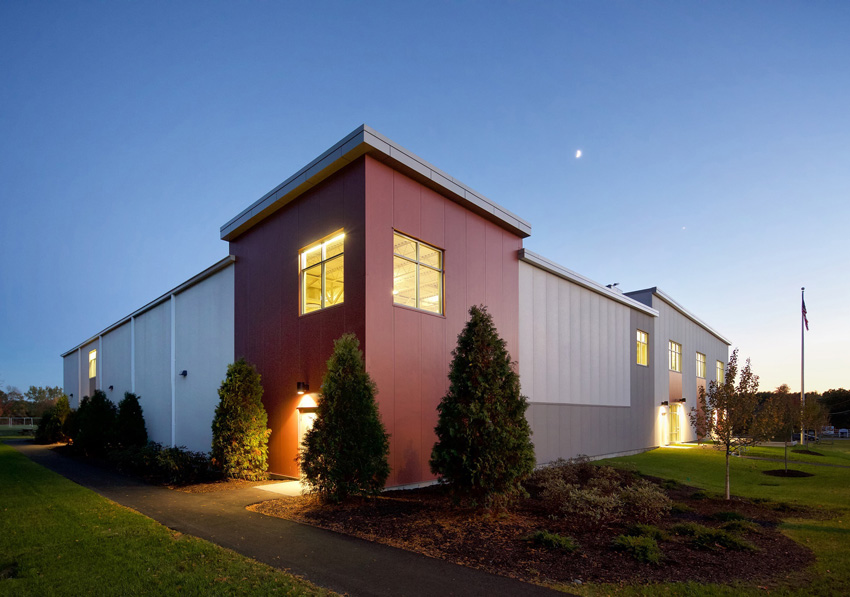
Photo courtesy of Metl-Span
An IMP in a striking red color and several shades of gray clad the Exeter YMCA in Exeter, New Hampshire.
“Do not carry or lift the panels in a flat orientation, parallel to the ground,” cautions Lehr. “This can cause the panel to flex or bend in the middle, which can delaminate the metal skin from the foam and cause a horizontal ‘blister’ to form at the edges of the panel.”
Most manufactures will allow the use of a vacuum lift, depending on the profile and finish used. Otherwise, a rope pulley system with a lifting end clamp suspended from the roof can be used. Another option is an end clamp with the use of a crane, adds Lehr.
On the issue of cutting, DPR Construction generally takes steps to try and avoid this; for example, utilizing 3-D modeling in place of 2-D shop drawings. “That way, if there’s a complex angle, we want to model it accurately so that the fabrication is precise before it arrives on-site, ensuring exact and quality installation,” Robertson says.
At the same time, if the tolerances are too tight, it will be necessary to field measure the panel or the wall behind the structural component where the IMP is mounted. In this case, DPR Construction plans the schedule and sequencing to take these measurements before ordering the panels.
“If we do have to cut on-site, it will undoubtedly be in a controlled environment,” she says. “We would prefer to enlist a certified IMP contractor who would have the capacity to take the material back to their shop to wrap whatever cut was made with metal panel material to keep the finish cohesive to help address vapor and water barrier concerns.”
For contractors undertaking this themselves, it’s important to never cut the panels with a torch, a reciprocating saw, or any saw using a composition abrasive blade. Some manufactures recommend cutting one side of the panel at a time, then using a knife to remove the foam for cutting holes.
When it comes to framing the panels, this is critical, as excessive variation from the plane of the wall can cause undue stress on the wall panels, joint, and connections, thereby creating an undesirable aesthetic and increasing the potential of oil-canning.
“The maximum deviation of the plane of the steel substructure should not exceed 3/8 inches +/- in any 20 feet length, horizontally or vertically. The deviation cannot vary more than ¾ inch on any building elevation and transition areas, such as corners and soffits, should not have girt steel within +/- 1/8 inch of the girt plane,” instructs Lehr.
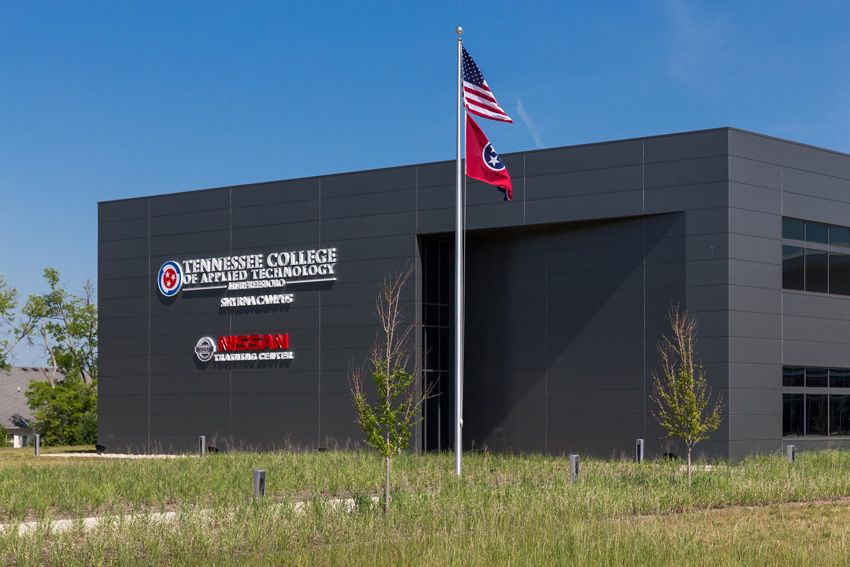
Photo courtesy of Metl-Span
Predominantly covered with high-performance IMPs, this 155,000-square-foot educational facility is state of the art inside and out.
The surface of the girt surface itself must be free of bolt and rivet heads, excessive welds, or any other obstructions which could prevent proper bearing, she adds.
More Details
When dealing with details such as cut backs, end laps, penetrations, and roof curbs, Robertson’s biggest piece of advice is “planning, planning, planning.”
By finalizing these details prior to placing the order for the panels, this lessens the chances of encountering mishaps in the field. “We try to model everything in addition to confirming these details and the shop drawings, and often utilize a third-party skin consultant to review these details.”
Robertson adds that the architect should always account for vapor and water barriers.
When an end lap joint is required, which is typically the case, the interior facing skin, called a liner, is usually cut. Once the liner is removed, a knife should be used to cut away the foam core, using a brush to clean away the foam from the back of the exterior skin. This will serve as the overlap onto the panel below, explains Lehr, the length of which will be determined by the manufacturer’s recommendations.
The end lap joints are then caulked and fastened, again according to the roof manufacturer’s recommendations. For wall panels, the use of a stack extrusion in place of an end lap joint is often used.
For penetrations and roof curbs, there are many possible variations and addressing these will depend on what the specific penetration and roof curbs look like, explains Elking. “To make sure the possible variations have been addressed, and to ensure the highest quality, we typically hire a third-party consultant to evaluate the many different environments coming into the building,” he says.
Overall, Patrick T. Johnson, PE, LEED Green Associate, CSI, CDT, Kingspan Insulated Panels, Columbus, Ohio, recommends a field mockup that encompasses a number of crucial conditions used on the project. “The mockup is normally tested per established air and water test standards, such as AMA 501.2 or ASTM E1105. The test mockup can be a separate structure or a portion of the finished work that is designated to be tested prior to proceeding.
Similarly, Robertson is a fan of modeling all major penetrations to identify exact locations. “This allows us to appropriately plan the design and fabrication, and weave these openings into the model and shop drawings to avoid cutting penetrations in the field.”
In Conclusion
An ideal solution for a growing variety of building types, IMPs are a win-win, combining aesthetics, energy efficiencies, and a full building enclosure solution.
“They are a simple, effective way to meet energy code requirements,” restates Haugh. “It’s a single product/system that provides an exterior skin, insulation, an air and vapor barrier, and an interior facing installed by a single trade.”
As more and more projects seek to leverage the technology’s benefits, well-informed designs and expert installations will continue to “lend credence to an industry that is capable of not only adding unique design elements to structures, but also being a building block of building envelope construction,” concludes Hooper.

|
The Metal Construction Association’s Insulated Metal Panel Funders Group comprises leading manufacturers, resellers, and suppliers who are dedicated to growing the use of insulated metal panels (IMPs).
www.metalconstruction.org
|








